新選西錦絵
A New Selection of Western Brocade Pictures
by Brian Pawlowski
Introduction by Alain Briot
Other essays in this series
Introduction
This site is primarily devoted to landscape photography. However, photography is larger than just landscapes and not all of us do just landscape.
Brian Pawlowski's work is a case in point. In addition to Landscapes, Brian does portraits and works on cutting-edge projects.
The project that is the focus of this essay is titled A new selection of Western Brocade Pictures. Brian's point of departure for this project is the Japanase Ukiyo-e woodblock print representations from the late 1800's. Brian "reinvents" the Ukiyo-e tradition by following the traditional iconography while using a camera instead of blockprints and by using contemporary scenes instead of traditional Japanese scenes.
In the process of creating these images Brian expresses a personal vision of this historical artform. The result is a body of work that is entertaining, fun and historically enlightening. Will it please everyone? Most likely not. Art never does. Remember that part of having a personal style is making your work personal. When you do that you please some while displeasing others. Personally, I am pleased with Brian's work and enjoy looking at his images. Take an open minded look at Brian images and decide how you feel about his project.
1-Artist’s Statement
Until the advent of photography, Ukiyo-e – pictures of The Floating World – were the mass produced woodblock prints feeding the appetite of the rising middle class preceding the birth of modern Japan in the late 1800’s. Depicting actors, stories from Kabuki plays, sumo wrestlers, sensational crimes, battles during the civil wars, and the pleasure quarters, ukiyo-e illustrated and defined the popular culture of decadent Edo (modern day Tokyo). Moving through this world, the last great ukiyo-e artists – Kuniyoshi, Kunisada and finally Yoshitoshi – became pop stars in their own right as consumers snapped up new prints and reprints capturing the rapidly disappearing world they lived in.
A modern Japanese artist, Masami Teraoka, appropriated the iconography of ukiyo-e to depict modern challenges of culture clash, sexual freedom, globalization and finally AIDS. Like his predecessors, he employed friends as models and often approached his subjects with humor. It was from that modern appropriation that I decided to embark on a melding of themes and approaches of ukiyo-e with photography. The images in this series reflect on my life, using friends and acquaintances within the (sometimes bizarre and violent) historical context of ukiyo-e and Japanese culture.
The content of the images are a composite of scans of design elements from original ukiyo-e prints, photographs captured with a camera phone and digital SLRs, and text translated into Japanese using the web-based Google translation service.
2-Structure of the images
The photographs are done in an ukiyo-e style (浮世絵), and the series title is a reference to a set of 23 diptychs by Yoshitoshi produced from 1885 - 1889.
The term Brocade Picture (nishiki-e and 錦絵) was the name used to describe the multi-step color woodblock prints that emerged in 18th century in Japan. These mass-produced images were the inexpensive posters and photographs of their day. Woodblock printing in Japan reached its height in the 19th century.

3-Derivations of the iconography
The signature cartouche is my first name in Japanese kanji, scanned from a carved wooden plank a friend once gave me. The oval red and yellow cartouche is the same signature style derived from Kunisada that Masami Teraoka also uses to sign his ukiyo-e themed works.
The title bar cartouche is scanned from the title bar of Yoshitoshi’s series New Forms of the 36 Ghosts – and contains the five kanji (Japanese ideograms) that translate as A New Selection of Western Brocade Pictures.
The text boxes and book graphic are scanned from two other Kunisada prints in my collection.
4-The Stories
A. I am worried.

Model did not show up. My son wanted to help.
Nikolai dressed up in wife's kimono.
私は心配しました。
モデルをすっぽかされた。私の息子を手伝ってくれた。
ニコライドレスアップして、妻の着物を着ています。
A replay of a watercolor by Masami Teraoka entitled “Travelogue series: Artist and Palm Tree.”
The falling flames (Hitodama) scans are from a late vertical triptych by Kunichika – the flames typically representing restless spirits. In this case, to get my son’s position right I told him to look up in the sky and he asked “At what?” To which I replied, “Imagine a plane just exploded and you see pieces of it about to rain down on you.” “Nikolai” is rendered in the phonetic script katakana – used to distinguish foreign words rendered in Japanese.
B. What a waste.
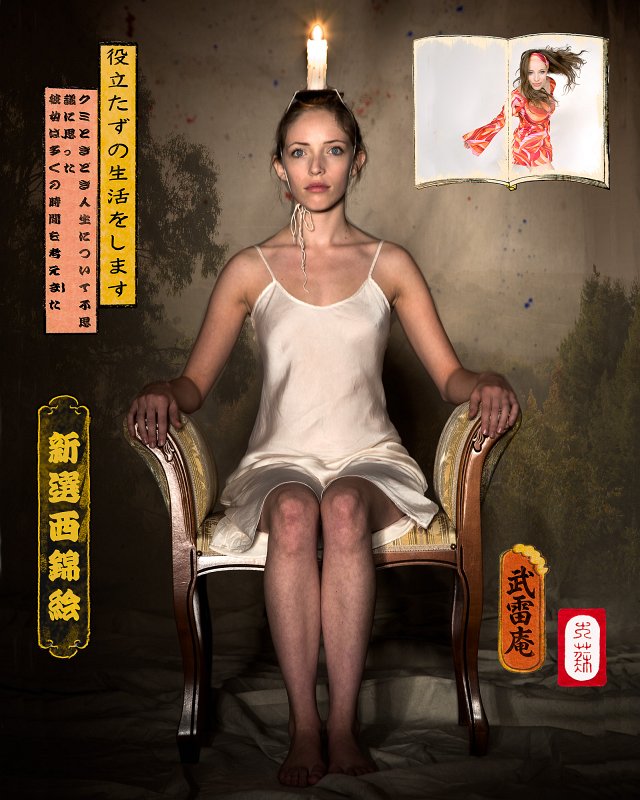
Nicole thought, “Modeling is fun.”
She became a candle holder.
ウロウロしています。
クミときどき人生について不思議に思った。
彼女は、多くの時間を考えました。
I once saw an ukiyo-e print of an old man tied to a chair with a candle burning on his head – his son for twenty years tried to break into the palace of the rival who had defeated his father (a general) – only at last to discover his father stark staring mad because he had been used as a human candle holder the time he was held captive.
C. Hanging in the air.

Kumi sometimes wondered about life.
She has time to think.
空中を漂う。
クミときどき人生について不思議に思った
彼女は時間を考えています。
A reenactment, with Kumi and Midori, of the most disturbing ukiyo-e work ever – The Hag of Adachigahara. This horrifying print by Yoshitoshi portrays the hag of Adachi Moor, a legendary figure who murdered pregnant women and drank the blood of their unborn babies. The flames (spirits) indicate impending doom.
D. In wine, truth.
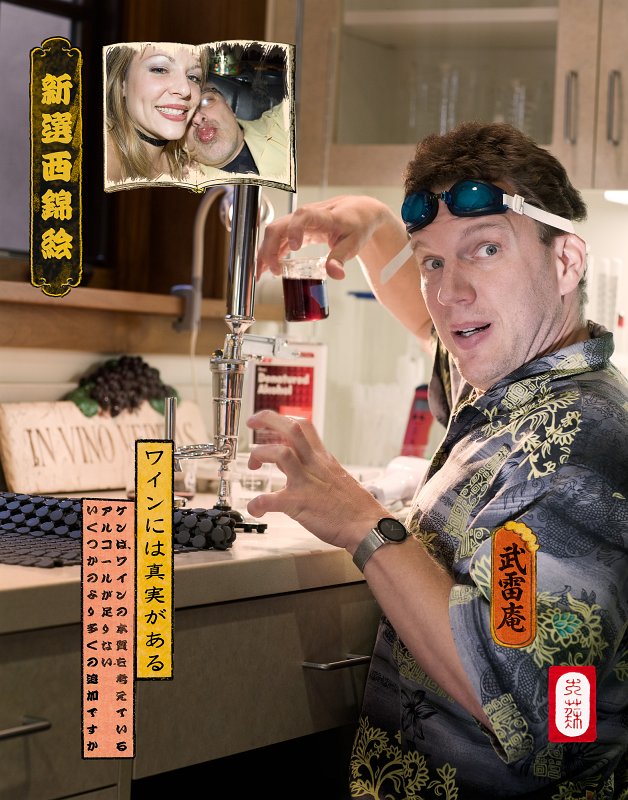
Ken ponders the essence of wine.
Not enough alcohol – add some more?
ワインには真実がある。
ケンは、ワインの本質を考えている。
アルコールが足りない-いくつかのより多くの追加ですか?
Ken’s wine analysis lab equipment and process reminded me of the laboratory of the scientist in the original Japanese movie Godzilla.
My strategy with Google translation was to enter an English phrase, and then translate to Japanese and then back to English to verify that the translation was approximately correct. I would then modify the phrase and sentence structure until I got a replay back of the original English. For the phrase Ken ponders the essence of wine I instead got back: Ken is the essence of wine on the brain.I decided to keep the original phrase that resulted in the unintended Japanese meaning.
E. The faithful retainer
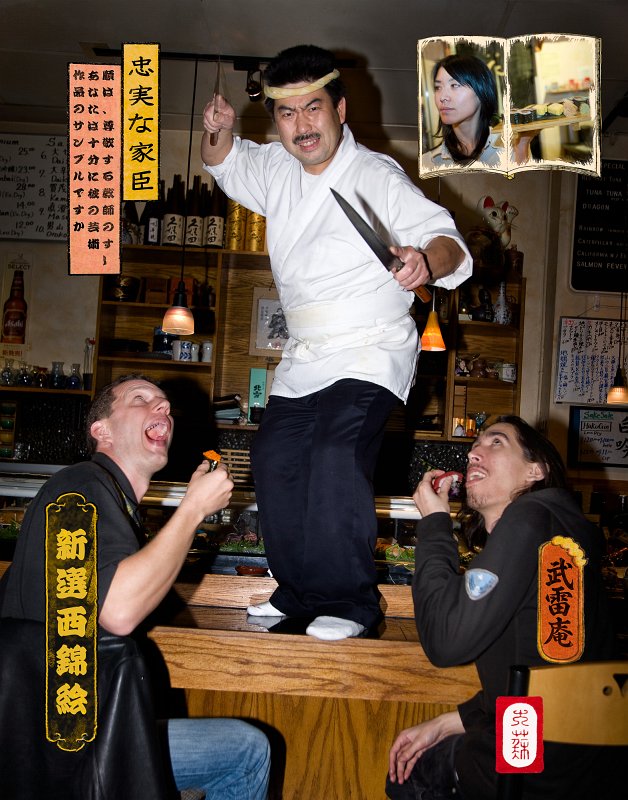
Jun is an esteemed teacher of sushi.
Are you good enough to sample his art?
忠実な家臣。
順は、尊敬する教師のすし。
あなたは十分に彼の芸術作品のサンプルですか。
Reflecting Kuniyoshi’s outstanding series from 1835 Chushingura. The prints depicted full body poses of the 47 Ronin – the faithful retainers who avenged their lord’s death. Inset image is a reference to Heavy – one of the images in Yoshitoshi’s series Thirty Two Aspects of Women (see image 10)
F. The flute player
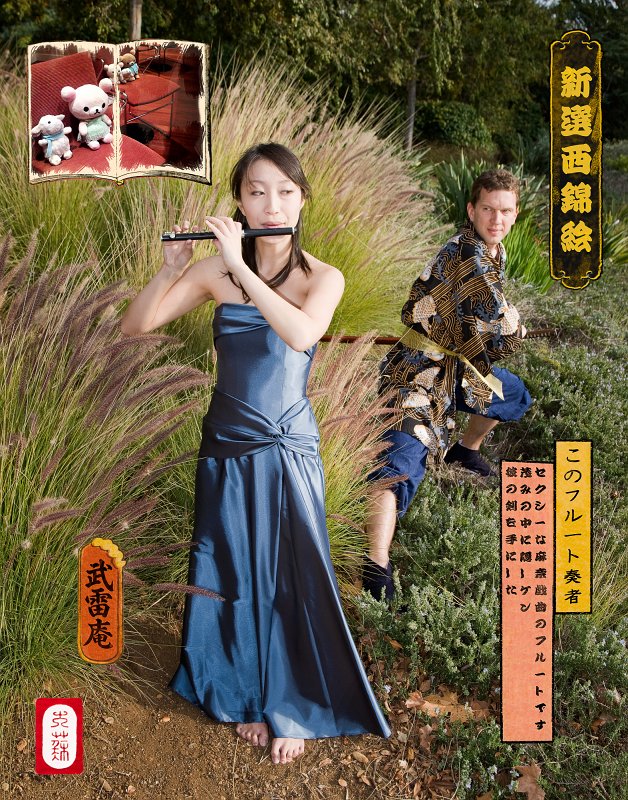
Sexy Mana plays the flute
Ken hides in the bushes – his sword in hand.
このフルート奏者。
セクシーな 麻奈戯曲のフルートです。
茂みの中に隠しケン-彼の剣を手にした。
A reenactment of Yoshitoshi’s most brilliant work simply titled The Flute Player by most people. The courtier was famous through Japan for his flute playing, a bandit was about to attack and heard the music and simply followed the courtier home. The courtier took off his kimono and handed it to the bandit saying, “Next time simply ask.”
G. A tasty dish.

Open for business – please be seated.
Misa laughs. Jun humbly asks for a small bite.
おいしい料理をする。
営業を開始-に装着してください。
美佐笑。 順謙虚に頼む小さな咬傷。
Several ukiyo-e artists did a series of bijin – beautiful women. Tongue in cheek, one series showed beautiful waitresses from famous Edo (Tokyo) restaurants carrying food – calling each “a tasty dish.”
H. A famous murder
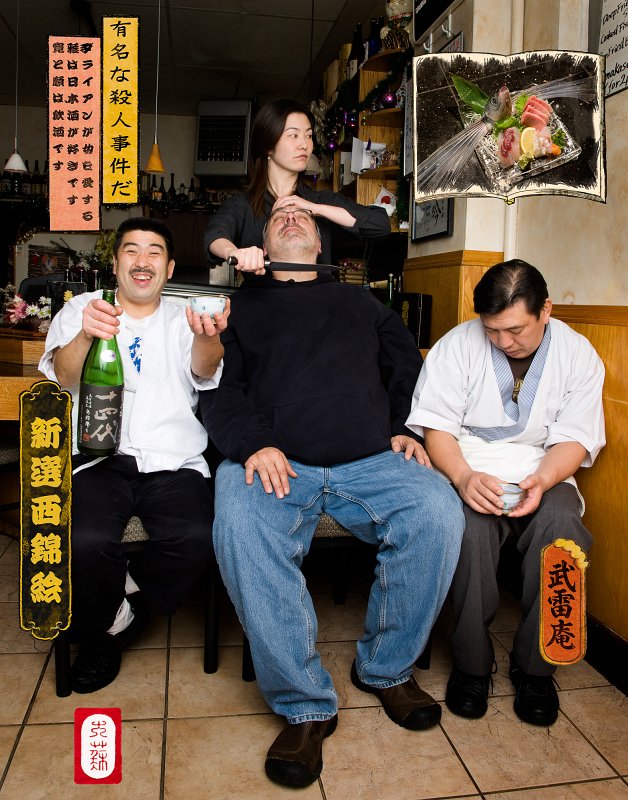
Brian loves a woman. Masako likes sake [rice wine].
Hiro and Jun are drinking.
有名な殺人事件だ。
ブライアンが女を愛する。 雅子は日本酒が好きです。
寛と 順は、飲酒です。
A self-portrait derived from the notorious series 28 Famous Murders with Verse by Yoshitoshi. Depicting horrifying acts of depravity – the series was very popular.
I was influenced by the painter Velazquez in the positioning of the figures and the use of a drinking theme: Los Borrachos
Jun prepared the sashimi.
I. Guy with camera (Camera man)
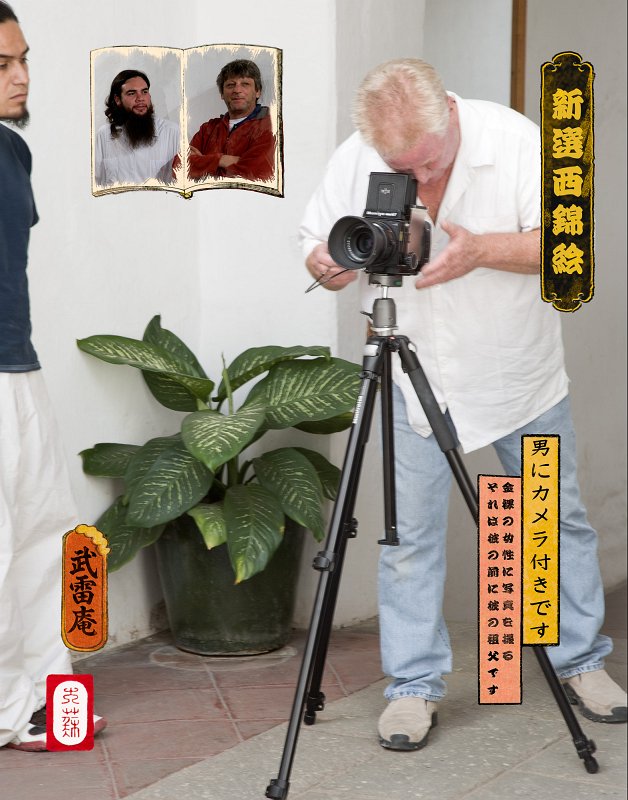
Kim takes pictures of naked women.
His grandfather did it before him.
男にカメラ付きです。
金裸の女性に写真を撮る。
それは彼の前に彼の祖父です。
Kim Weston photographing in Oaxaca, Mexico. Inset of Antonio Turok and the director of the Manuel Alvarez Bravo Center for Photography in Oaxaca.
J. Enjoying a stroll
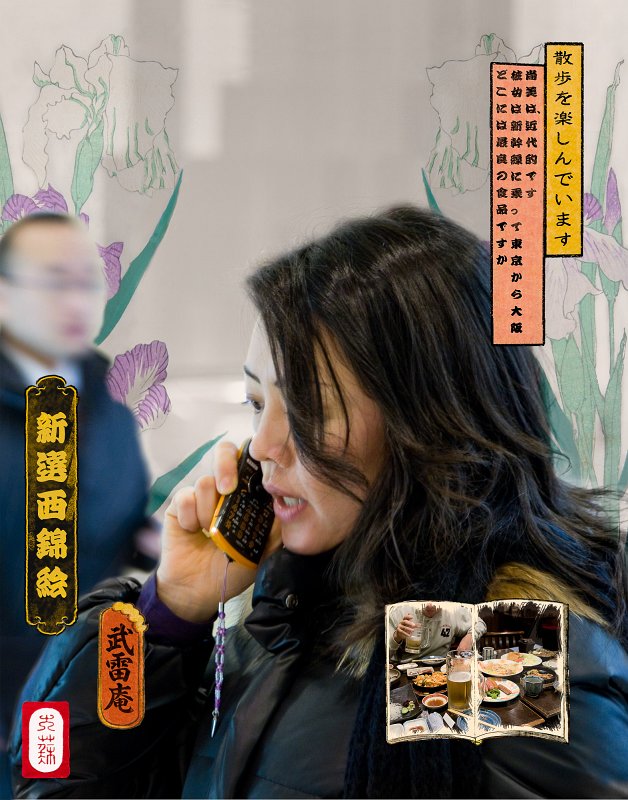
Naomi is modern. She rode the Shinkansen (bullet train) from Tokyo to Osaka.
Where is the best food?
散歩を楽しんでいます。
尚美 は、近代的です。彼女は新幹線に乗って東京から大阪。
どこには最良の食品ですか?
Met Naomi in Osaka – a Japanese city known for its cuisine. We were trying to find a good restaurant to eat at – and walking a lot.
The “modern” reference is to the last image of Yoshitoshi’s Thirty Two Aspects of Women. The image depicted a noble woman of the Meiji Era in western dress – and is the most famous image of the series.
Just a brief note – there are many variations in the kanji used to represent a Japanese proper name. For example, from most popular to least popular, Naomi can be represented as:
This Naomi’s kanji above is the second one.
5-Notes on translations
I used Google to translate from English to Japanese. My first attempts were met with utter confusion by Japanese native speakers trying to read the text. I started verifying the translations by translating them back into English and tweaking the word choice and sentence structure until I got something potentially understandable. I had to use English names as placeholders which I replaced with the correct Japanese names (in kanji) by hand (Google did not handle Japanese names in English well). Japanese personal names have many variants for the same names – Aki Ueno helped sort it out.
Translation web site:
http://translate.google.com/translate_t?langpair=ja|en